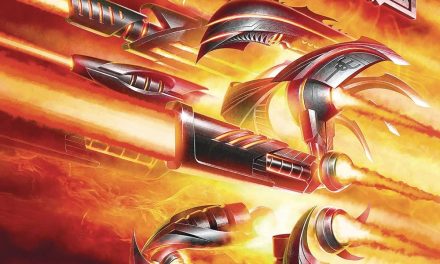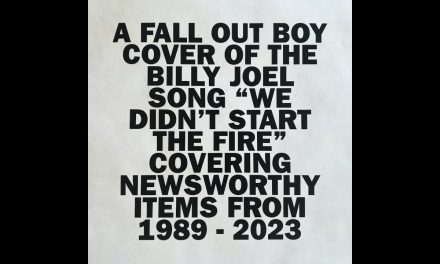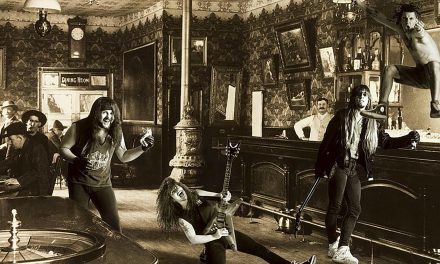If Black Sabbath are the grandfathers of heavy metal, then Judas Priest is the father that outdid them in almost every way. If you ask me to show someone what heavy metal is, I won’t hand them a copy of Paranoid or Master of Reality. I’ll instead hand them a copy of Screaming For Vengeance, British Steel, or Painkiller. That’s what Judas Priest means to the heavy metal community. Without them we wouldn’t have a classic look for heavy metal with studs and leather.
Thin Lizzy and Wishbone Ash might have been the first to use the twin-guitar attack, but Judas Priest was the one that solidified it in the heavy metal sphere. K.K. Downing and Glenn Tipton were and still are probably the best twin guitarists for any band. It was set to be the 50th anniversary celebration for Judas Priest this year. To make up for those shows being postponed, it’s high time for Judas Priest-A-Thon. The brother to the album by album reviews, Iron Maiden-A-Thon and the cousin to our series of Rush album reviews. You’re going to be getting a Judas Priest album review, every business day, until we’re all through.
Rob Halford picked the absolute highest point to leave Judas Priest. Painkiller is their (I would say unquestioned, but fans of Stained Class have made themselves known) masterpiece. Today’s review is uncharted territory for Judas Priest. They had to move on with a new singer, and a new era of music. Would it work? Let’s find out if Jugulator is up to snuff for the band.
Background On Jugulator
The biggest thing about Jugulator and the elephant in the room, is that Rob Halford isn’t singing on it. Judas Priest went four years without a peep. They released the Metal Works 73-93 in 1993, which had some help from Rob Halford. That release would be the last thing we’d see from the band. Without word on a new singer or any releases, Judas Priest sort of just floated in space. Fans of the band wanted some news, any news. In 1996, Judas Priest fans would get news that would change the course of the band.
A former lead singer for a Judas Priest cover band, named Tim Owens was their new lead singer. For the first time in seven years, the band would have a new release. Unlike Iron Maiden who waited no time in replacing a godly figure at lead singer, Judas Priest took forever. The band went into the studio in 1996 to record the new album, Jugulator. It was recorded at Silvermere Studios in Surrey, England.
This album, would divide fans. There were those who just wanted some new Judas Priest, and also like Iron Maiden, the other half, would be dickheads who couldn’t accept that the band was making new music without their long-time singer. As you can probably tell, I’m in the first camp. I’d rather see new music from one of my favorite bands, than see them die out without a fight.
More Background On Jugulator
Jugulator wouldn’t sell as well as the previous Judas Priest albums. Heavy metal and CD sales were down across the board in the 1990’s. The titans of the 80’s were blindsided by a multitude of factors in regards to sales. Grunge changed how popular metal was seen. Napster and other programs like that curtailed CD sales. The landscape of culture was just much different in 1996 than it was in 1986. It peaked at Number 82 on the US charts. And it didn’t go Gold, breaking the streak set by Sad Wings of Destiny.
Musically, Jugulator was much different than previous albums. It retained the heavy tone of Painkiller but it was much more influenced by the groove metal of Pantera and other bands popular at the time. In addition to this, the band’s guitars were tuned down to C or C# for the first time. These changes help set Jugulator apart from it’s previous brothers in Priest, but would it make for a good album? Let’s find out.
1. Jugulator
“Jugulator” starts off with a very Judas Priest sound of metal crunching and moving. You can tell this is influenced by the music of the time in Nine Inch Nails and Pantera. It’s a more industrial and groovy Judas Priest song than any before. Ripper Owens shows that he’s more than capable of stepping in as the lead singer of Judas Priest. With a vocal register similar to Rob Halford, he’s a solid choice. “Jugulator” is a solid opener for this album that sets the tone for what you’re going to get.
The song speaks about the beast on the front cover, in tandem with the Painkiller Angel, the Jugulator is an end-of-the-world causing beast that terrorizes people. Those who weren’t saved by the Painkiller are left to die at the hands of the Jugulator. It’s a pretty metal sounding concept that I’m appreciative of.
2. Blood Stained
Starting off with another industrial sound and then into the brooding guitars, “Blood Stained” was seemingly the standout song from Jugulator. Along with some other songs, this one was one of the four songs played in concert from this album. It’s a better song than the title track and I think this one would have suited the album better being the lead track.
It talks about how there are people in positions of power that cause trouble and chaos for the sake of earning money and power from it. It’s a topical song that is brooding, but also groovy and kicks some ass. It’s a good one from this album.
3. Dead Meat
“Dead Meat” is where the album sort of takes a turn to the more generic side of things. It sounds similar to other tracks on the album, and if not for the lyrics, I wouldn’t really be able to tell the difference. It’s about the human race and how they’re naturally rebellious. It sounds good enough, and it’s pretty easy to headbang to, but not one that I listen to a lot.
4. Death Row
Now here’s a riff that sounds similar to older style Judas Priest. It has a new groove facelift, but it’s definitely more inspired by older songs. “Death Row”, if you can guess, is about death row. Told from the point of view of the person getting set to the electric chair, it’s actually a much better song than others on the album. I enjoy this one, it sounds pretty silly on the first listen, but it’s got some progressive sound to it. It very much sounds like old Judas Priest mixed with newer stuff.
5. Decapitate
Another plodding, groove-themed song, “Decapitate” takes from Pantera’s stylings a lot. It tells the story of means of corporal punishment like guillotines and such. It’s a really heavy subject matter, but the song itself is nothing special, sadly. I’ve listened to it a couple times and forgotten that it was playing. It just gets lost in the shuffle and is an easy skip for me.
6. Burn In Hell
This one starts unlike most of the songs on the album. “Burn In Hell” was the lead single from the album, so it’s a little strange that it’s stuck here in the middle of the album and not at the front end. The song is more classic Judas Priest than the groovy stuff on this album. I could see the band playing this one today, even with Rob Halford singing. Ripper Owens hits some impressive notes on this one, and it makes some of my playlists. It’s a solid song from this record.
7. Brain Dead
“Brain Dead” is a song that might have some of the deepest content on the album. It’s about assisted suicide, and what happens when someone is in a coma from an accident. Similar-ish to “Beyond The Realms Of Death”s lyrical content, the narrator is stuck in their own mind after an accident and just wants it all over. It’s very heavy and isn’t the best song on the album, but it’s listenable. There always is a question about people who are in coma or assisted living, this song tries to answer that question, and that the person can hear and feel everything that is going on around them.
8. Abductors
So we’ve gone from an apocalyptic monster, to death row, to assisted suicide, now to alien abduction. The lyrical content on this album is definitely more dark and heavy than any Judas Priest album before. It’s about how those that get abducted, are vilified and no one believes their tales. This is a truly terrifying song if you really look at the lyrics. I can’t say that I really like it, but the lyrics paint a horrifying picture.
9. Bullet Train
The other single from this album, “Bullet Train” is an interesting choice for that honor. I’d feel like “Blood Stained” and “Burn In Hell” were the two songs from the album that sounded better than this one. It’s about some sort of substance abuse. Whether that’s alcohol, meth, or something else, it doesn’t really matter. Ripper Owens really shows his vocal range on this track, and while I wouldn’t say it’s a classic, or even the best song on this album, it’s worth listening to.
10. Cathedral Spires
‘Deep breath’. This track is worth every penny, every minute of the songs before it, if you hate Ripper Owens and his time in Judas Priest, this song is worth all of it. It’s hauntingly beautiful. An epic song to match any other Judas Priest song in their catalog. It’s also quite the lengthy song with different changes to the song as it goes along. The groove metal is toned down and it’s just charging heavy metal here. Ripper Owens belts out this one and it’s a shame that they never played this one live when he was in the band.
The song finishes the narrative arc of “Jugulator”. In the song people are watching from high atop towers as the beast tears apart the world, waiting for his arrival to their towers. You can see it as a bash on religion also, as cathedral spires have religious connotations to them. I can’t get away from this song, and it shows a side of Judas Priest that wasn’t seen for awhile, and frankly, hasn’t been seen since. If you’re going to listen to one Ripper era Priest song, it’s this one. I would love to see Judas Priest play this one with Rob Halford belting it out.
Aftermath of Jugulator

Jugulator is a mixed bag of an album to me. It has three really solid songs in: “Blood Stained”, “Burn In Hell”, and the mighty “Cathedral Spires”. The rest of the songs on the album all sort of blend together and don’t stand out. I’m also not a fan of the groove metal genre in general. I think the 90’s were a cesspool of bad bands that got big in metal. I’m not a fan of the later 90’s albums from Pantera that inspired this release. Give me Cowboys From Hell and even the Power Metal stuff over any of the crap they released in the mid 90’s.
In addition to the new lead singer, the classic Judas Priest font was changed for the first time in ages. I know it was a new era for the band, but that’s like Iron Maiden fundamentally changing the font for their albums. It’s a change that I don’t agree with. The album art for Jugulator does look a bit silly now also. Instead of the badass apocalyptic landscape of Painkiller we get a sort of demonic looking Muppet. I would rather have seen the Jugulator in action ripping someone apart or something like that.
So while this album has some good songs, it doesn’t live up to any lofty expectations that people might have had for it. Ripper Owens performs admirably, and his performances with the band are great. He sings like Rob Halford and also found a way to be his own person on this album. It’s just held down by the musical trends of the time. Coming after a four year hiatus and the release of Painkiller doesn’t do this album any favors.
The Score
Because of this, I can’t give the album any higher than a 6/10. It’s just too generic, the musical stylings and tone are too dark, and it suffers from the music of the time. Besides those tracks mentioned above, after listening to it for the first time, you can skip most of them. “Cathedral Spires” is a true Judas Priest classic, so it holds this album’s score up more. I also can appreciate the job and how difficult it must’ve been for Ripper Owens and the rest of the band to follow-up Rob Halford.
The band would tour in support of Jugulator in 1998, but would go on another hiatus until 2001. It was a lull period for the band where sales and concert tickets were down. You’ll have to find out about 2001’s Demolition tomorrow. That album might be the most notorious in the Judas Priest catalog.
For more on Judas Priest, heavy metal, or any other general pop culture, make sure to check back to That Hashtag Show.
All images and music are courtesy of Judas Priest.






